So, do you think you’re ready for your road trip in Portugal? You’ve rented the car, you’ve made your itinerary, and you’re only a few weeks away from arriving and exploring Portugal’s quaint villages, stunning beaches, and beautiful castles. There’s only one more important thing we need to discuss and it’s one of the most confusing but also the most important – the toll roads!
Portugal has quite a collection of toll roads spreading across the country. For travelers not used to encountering so many toll booths, this can seem like a lot. And, trust us, the tolls can add up, but knowing how to navigate the toll roads will help you have a much better experience and make your journey much smoother as you explore the beautiful Portuguese countryside.
We’ve created a handy guide and included the most up to date information that we could find to ensure your road trip is a memorable one without unexpected toll fees along the way. Trust us, the more you know in advance, the better your journey will be. Let’s get on the road!
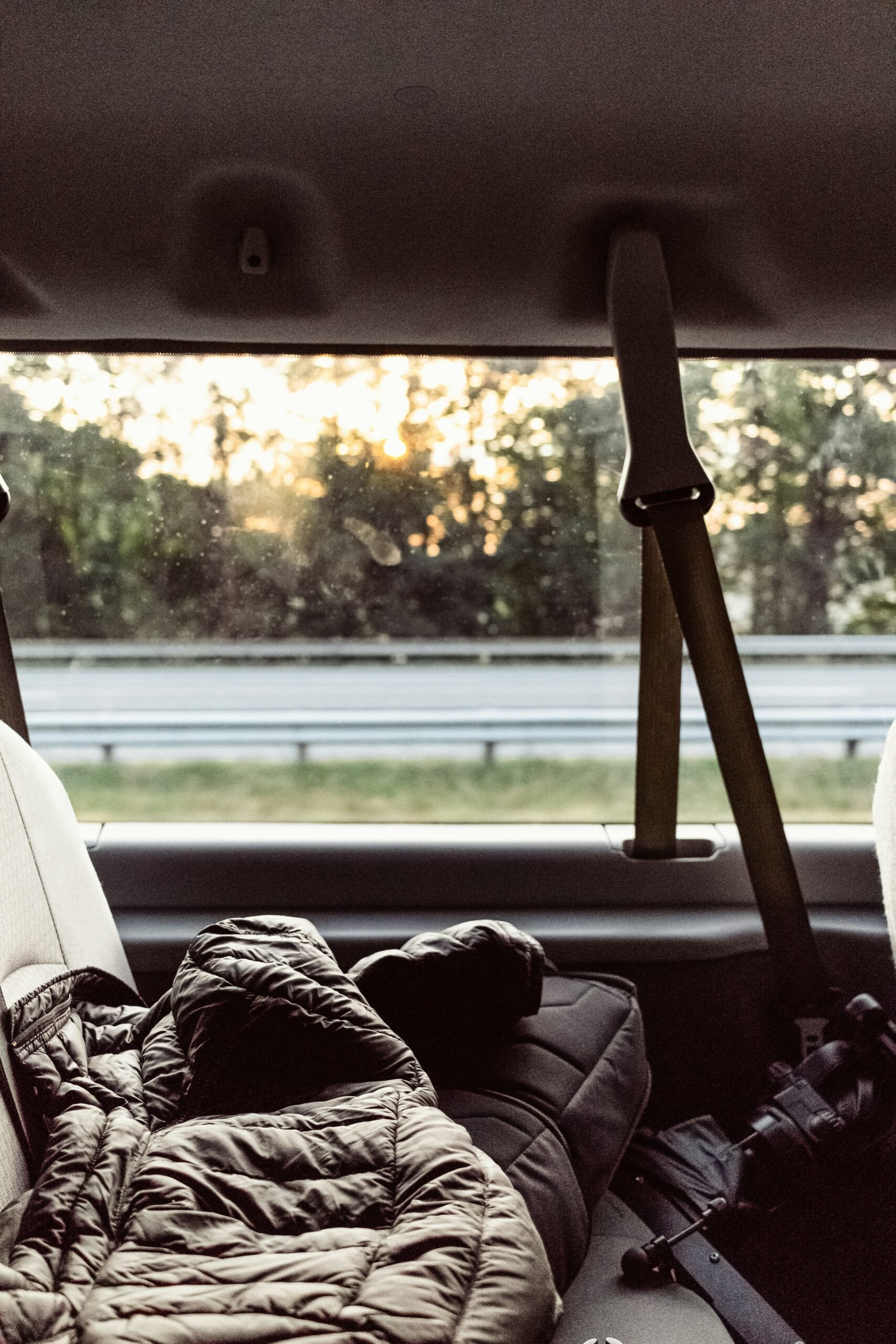
Which GPS app should I use in Portugal?
Before we even begin, let’s talk about the most important tool you will have along the way: GPS navigation. Whether you use voice activation or follow the screen, GPS navigation will be essential to finding your target destination with ease.
You have two options: Google Maps or Waze. We recommend downloading both for your journey. Both allow you to choose the option to avoid toll toads completely and show updated traffic information. The only major difference between them is that Waze will show you what you need to pay for tolls in advance, which can be very helpful.
Where are Portugal’s toll roads?
Portugal’s toll roads extend across the country. Just like toll roads elsewhere, the money that you pay to use part of the road goes towards its initial construction and its future upkeep by the local government.
In Portugal, you will find a mix of national roads (Estradas nacionais, EN), main routes (Itinerários Principais, IP), motorways (Autoestradas, AE), municipal roads (Estradas Municipais), and complementary roads (Itinerários Complementares, IC). A large portion of these roads are electronic, but they can also have conventional tolls with booths.
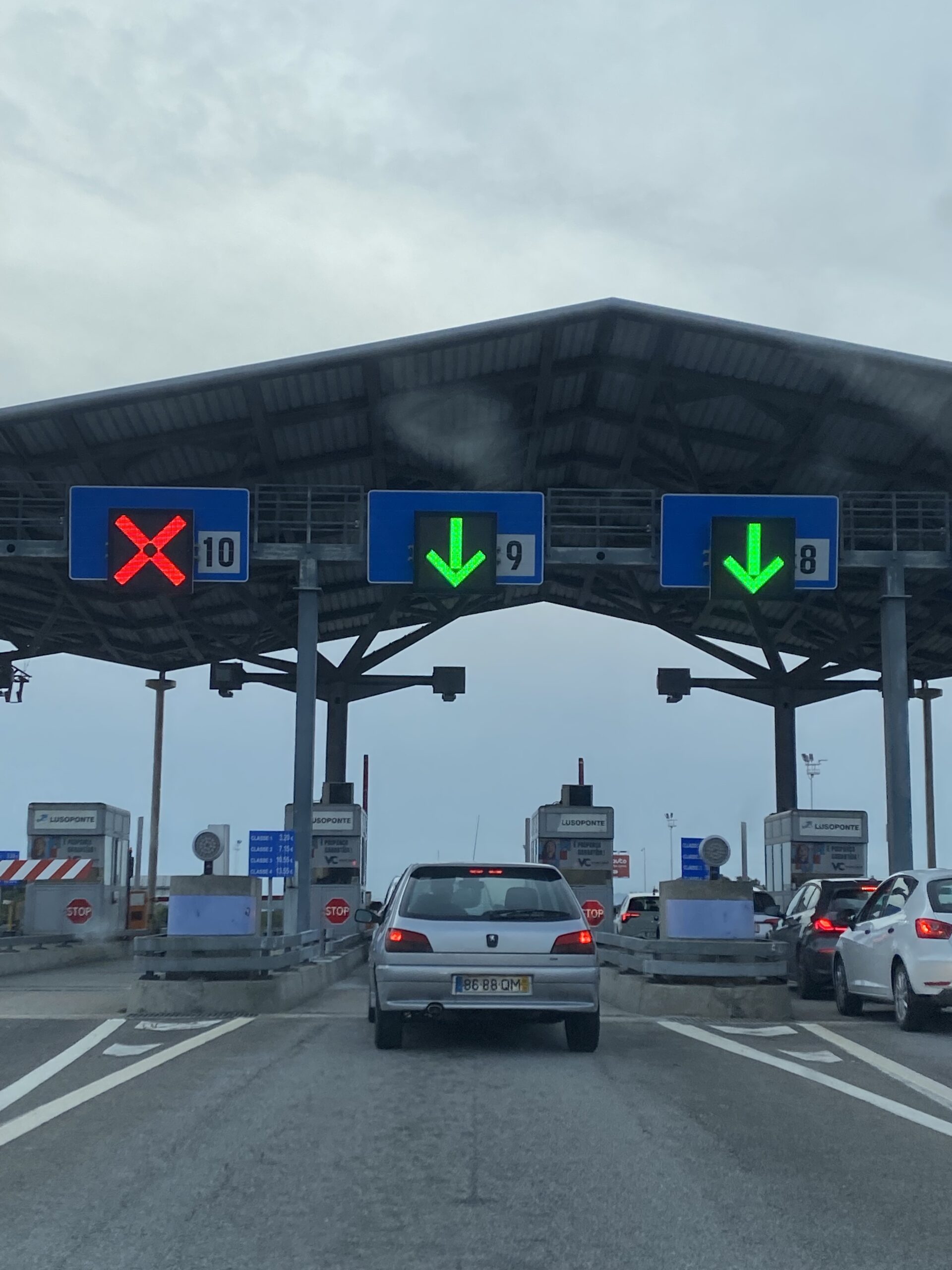
What are the types of toll roads in Portugal?
- Electronic Toll Roads: Let’s start with the most common type of toll road. In 1991, Portugal implemented an electronic toll system known as “Via Verde,” which is now available on all toll roads and bridges throughout the country. This system uses automatic sensors to detect electronic toll responders.
- To use Via Verde, you will need to have a transponder attached to the inside of your windscreen. Then, you can drive straight through toll booths without stopping in designated “Via Verde” lanes. All tolls are being automatically charged to your credit card. Read more about this later.
- Traditional Toll Roads: These are the typical toll roads that you’ve seen where drivers pay their fees to a real live person in a toll booth. In Portugal, there are also toll booths where you need to stop and pay a machine with a debit/credit card instead of driving straight through.
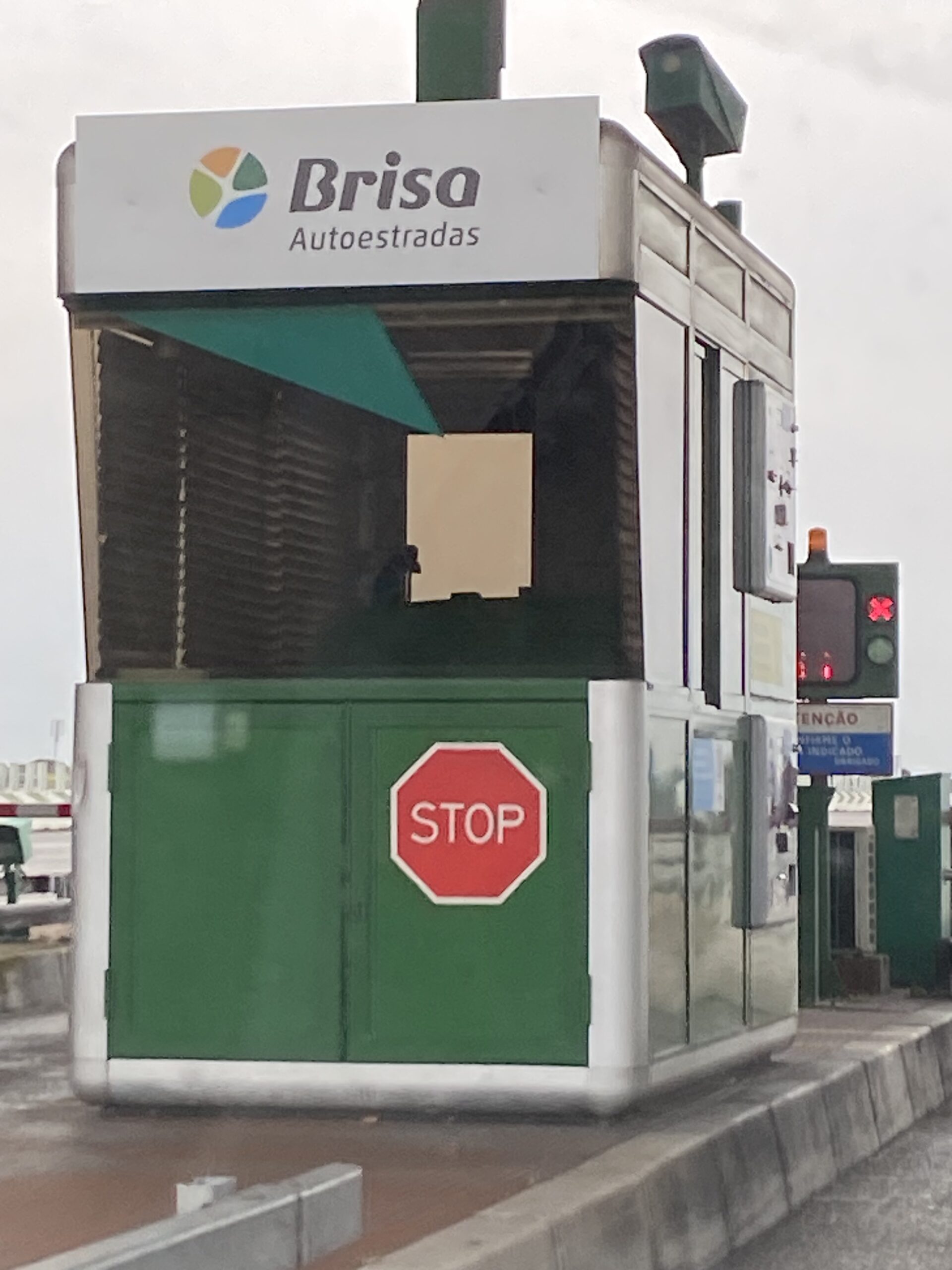
- When paying to a real live person, you can pay with cash or credit card. Make sure to have euros on hand as almost all toll booths only accept local currency. Never assume that a toll booth will accept foreign currency. The tolls can add up so we recommend having two different credit cards on hand to make payments in case one does not work.
- Toll Service Stations: Throughout Portugal, there are also designated CTT Payshop service stations that allow you to pay toll fees manually. These stations accept Via Verde payments, cash, and credit/debit cards. See more on Payshop later.
What are some of Portugal’s major toll roads and associated costs?
As of January 1, 2024, the
- A1 – Driving between Lisbon and Porto costs €23.90,
- A2 – Lisbon to the Algarve costs €22.70
- A25 – The main road that connects the central region of Portugal to Spain and the rest of Europe. The cost of going from Viseu to the Spanish border crossing at Vilar Formoso costs €3.70.
- A22 – This extends west to east along the Algarve, going further into Spain. It was not originally meant to be a toll road so it does not have toll booths, instead relying on an electronic toll system. A drive from Lagos to Faro will cost you €2.70.
Does every car pay the same for the toll roads?
The short answer here is no! In Portugal, there are four classes of vehicles, with Class 1 being the least expensive and Class 4 being the priciest. Generally, motorcycles and small cars are considered Class 1.
If you have a van, truck, or RV with two axles and a height of 1.10 meters or higher at the front axle, you will be considered Class 2.
Class 3 is for vehicles with 3 axles and a height of 1.10 meters or higher at the front axle (generally large RVs with a trailer or trucks with three axles).
Finally, Class 4 is reserved for large semi trucks with four axles and a height of 1.10 meters or higher at the front axle.
Some Class 2 vehicles, when using a Via Verde device, may pay the same as Class 1. However, some drivers have reported that Via Verde will sometimes charge double for foreign registered cars compared to Portuguese cars. Therefore, do not be surprised if your French-registered SUV, which you believe is a Class 1, gets charged as a Class 2! Please plan ahead in your budget for this to possibly be the case.
To give you an idea of the costs, to cross the Ponte 25 de Abril bridge, Class 1 currently costs €2.10, Class 2 costs €4.60, Class 3 costs €6.20, and Class 4 costs €8.05.
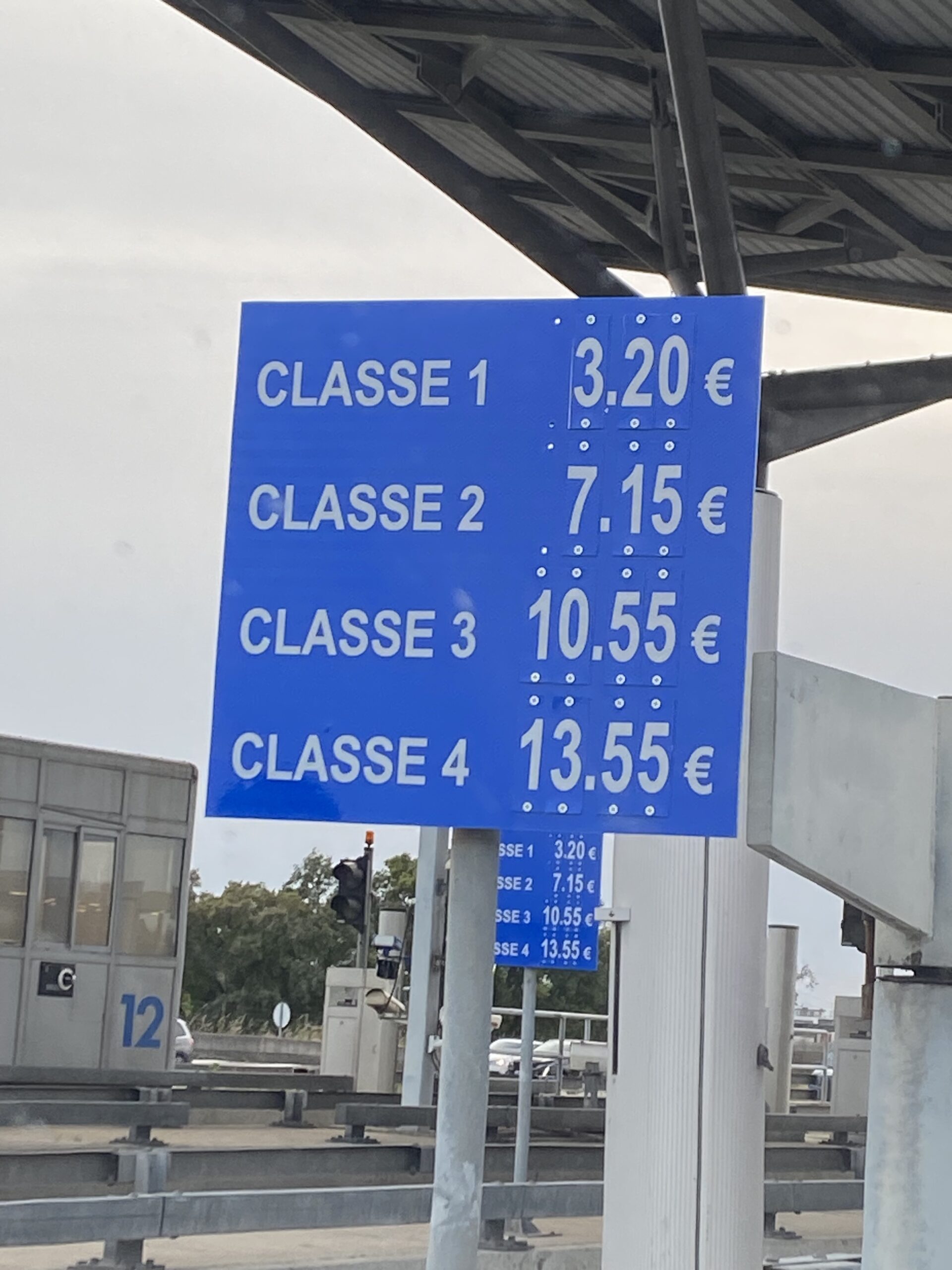
Can I avoid paying for toll roads in Portugal?
If all of the above sounds too complicated, you can actually avoid almost every toll road and not pay a dime. The catch? Taking an alternative road may take a lot longer, and the road itself will not be so well maintained. The upside? You will have more time to enjoy Portugal’s beautiful scenery and go off the beaten path to discover incredible new places. This is when you might just make some of your most treasured Portuguese memories.
How do I pay for toll roads in Portugal?
We’re going to keep it real here. This can definitely be the trickiest part of the toll road experience in Portugal. When you enter the first section of a toll road, you will usually pull up your car and simply take a ticket from a machine which you will need when you exit the toll road.
Do not lose this ticket! Put it immediately into your wallet or purse, as putting it on your dash or between the driver and passenger seat runs the risk of having it fly out of the car when you least expect it.
Driving on the bridges in Lisbon works the same way. You don’t need to pay when you leave Lisbon, but you to take the bridge back into the city will require a toll with several different lanes for different payment methods.
The first step is getting into the right lane so you can prepare to pay in the right way for your situation. Roads that haven’t gone electronic yet still have booths where you can pay with a debit or credit card. However, we should warn you – there are still the rare booths out you that may not accept non-Portuguese bank cards, so make sure that you have some change ready as a backup plan.
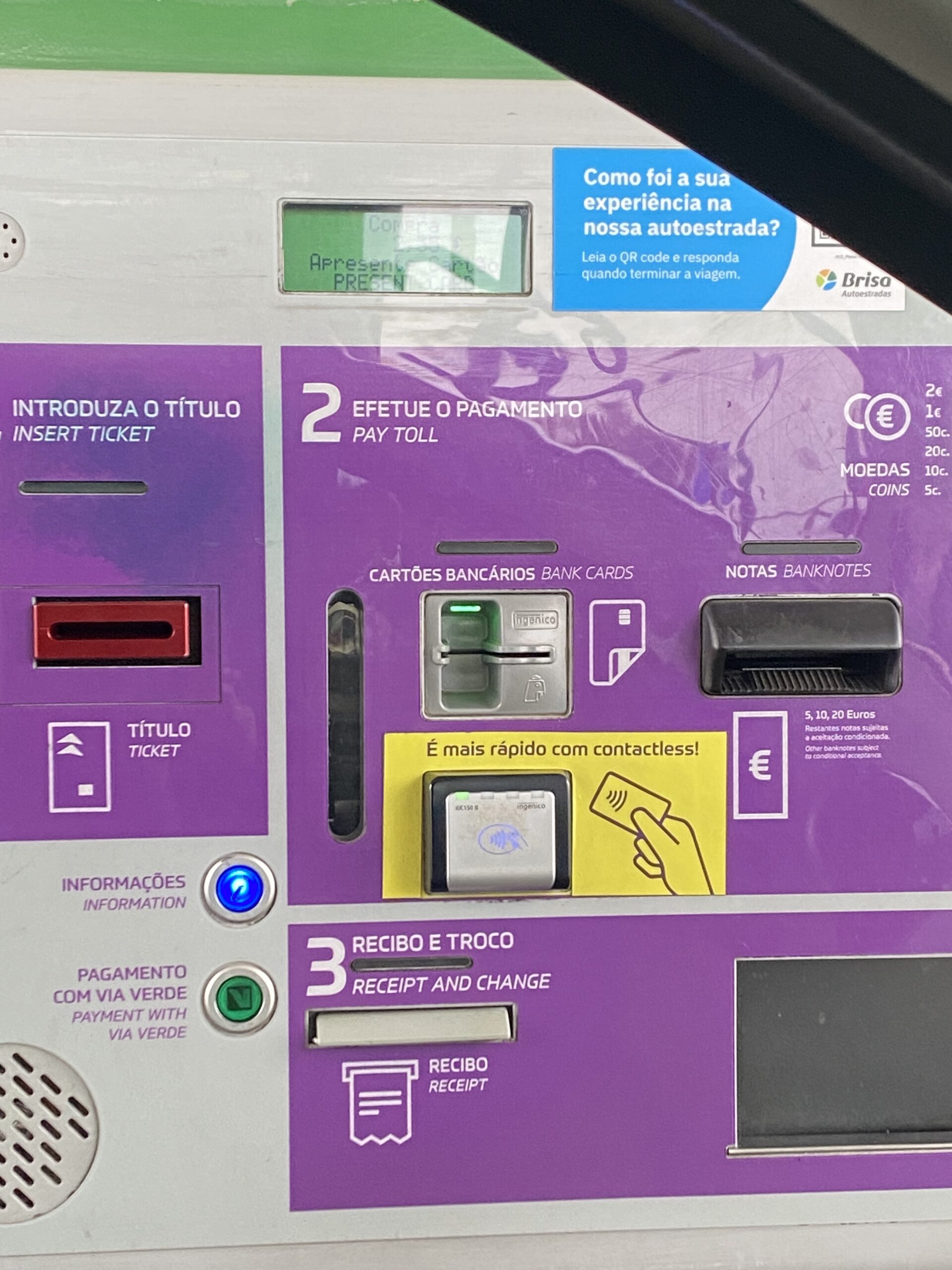
If you have the Via Verde electronic responder, you can go through the lane labeled with the Via Verde sign, which looks like this:
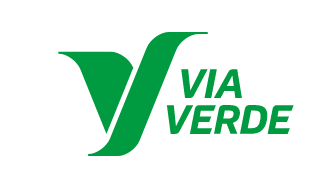
You will not need to stop if you go through a Via Verde lane. If you see a toll booth stop that everyone is driving through without taking tickets, this does not mean that you may not be charged, it just means that you have been charged automatically through the electronic scanning of your license plate or sensors set up to record each vehicle’s entry and exit.
Paying the tolls that get charged automatically will be handled in different ways depending on where your car is registered.
If your car is registered in Portugal, the key thing to remember is that you won’t be able to pay these tolls for the first 48 hours. After they appear on your bill, you only have 15 working days to pay, after which you are considered late and will be charged a fine. You can pay the tolls at a registered Payshop, which looks like this:

or at local post office, which has this sign:

If you’re renting a car registered in Portugal, you can alternatively ask them to attach a responder to your windshield for your trip. The responder can be preloaded with credit, which will allow you to pay the tolls automatically as a debit to your prepaid amount. This will also grant you access to the Via Verde lanes.
If your car has been registered in another country, you have a few options to ensure that you can make toll payments. We recommend either signing up for EasyToll online or buying a toll card from an Easy Toll Welcome Point, tourism office, service station, or local post office. You simply add prepaid credit to it and then activate it through a text message.
You only have until 11:59 PM of the day when you first use electronic tolls on the highways to subscribe to Easytoll. After that, you will have to go to the Portugal Toll Payment site to pay your toll plus a fine.
Other forms of payment for cars with foreign license plates, including Easytoll, Tollcard, 3-day Virtual Card, and Multi-Journey Virtual Card can be found and are explained in good detail at PortugalTolls.
It is also possible for foreign registered cars to sign up for Via Verde Visitors and get a transponder to track payments. The transponder is guaranteed for life and you only pay for the months that you use the service. In this case, payments will be made using an international credit card.
As we mentioned above, some drivers have reported that their class 1 international vehicles have been occasionally charged as class 2 when going through some gates with Via Verde. This can be hard to fight once payment is debited, but it is something to be aware of and possibly make room for when you’re tracking total toll payments. Check here for frequently asked questions and customer support details from Via Verde.
Using Toll Payment Systems from Other Countries
Portugal has great interoperability with Spain, as all Spanish Via-T devices can be used on national highways including electronic toll systems and Via Verde lanes. French drivers are not so lucky as only some devices are currently accepted. We recommend checking with your transponder company to ensure that the transponder service is still active. It may be worth contacting either the Via Verde office at +351 210 730 300 to see if they know whether other transponders are accepted.
How do I check if I have tolls to pay?
Luckily, if the system is working as it should, there are two easy ways to check if you have tolls to pay. The first is to call the Portugal Toll Office + 351 212 879 555 (for international calls) or 707 500 501 (for national calls) and see if anything has been registered to your car.
The other is to check the Portugal Toll Payment site, which is available in Portuguese, English, Spanish, and French. Please note that your payment may not show up here for at least 30 days and you cannot make payments directly on the site. You will instead be directed to different payment portals. Don’t be surprised if you get a letter about unpaid tolls if you don’t get a transponder with Via Verde and or check the Portugal Toll Payment.
Final Thoughts
Now that you understand much more about Portugal’s toll systems, we hope that it will give you the confidence to explore the amazing Portuguese countryside with ease. Portugal offers such a wealth of history, gastronomy, and culture in a very manageable size. To inspire you to get out on the Portuguese roads, check out our collection of epic road trips including Portugal’s lighthouses, castles, and even a journey unveiling the hidden beauty of National Road 2. See you on the road!




Hi, thank you for this valuable information!
Is it the same price for toll readers as for direct payment at the booth?
Or said differently, does using the reader gives some promotions at the toll?
My van rental company charges 20 Euro for the activation of the reader.
So I guess, what I would pay for, when getting this reader, is simply the covenience of going faster through the tolls, right?
That could be a valuable information to add to the article.
Best regards
Dear Hubert, Thanks for this important question. We will add more information to our article to make this part clear. Basically, there are some toll roads in Portugal that do not allow direct payment at the booth, and your car rental provider will receive a fine if you drive through a toll road without an active transponder. This fine will then be passed onto you or will be taken out of your security deposit as well as a possible additional administration fee. Car rental providers usually have transponders already fitted within the vehicle and the set fee that you pay is an admin fee for the transponder. Any toll charges incurred will be deducted further from the deposit or your credit card. I hope this is helpful!
Perhaps you could choose a different photo than the 2nd in this article? As soon as I saw it, I thought “that map isn’t Portugal, it’s New South Wales!”. The ocean is on the wrong side for a start. In fact, I have that exact map in my car in Sydney.
The attribution, though – “Road trip life” – is appropriate: the map is in a road atlas my family used while spending 6 months driving around Australia. At a guess, the view is south from somewhere like Evans Head – B15 on that map!!!
Hi Dave, we want to thank you for your enthusiasm of road trip life and your interest in this article about Portugal. We can only imagine how much fun driving around Australia must have been for six months with your family! We have uploaded a new “Road Trip Life” photo. Let us know what you think!
Is the A1 fully electronic or can we still use cash at booths? The article doesn’t say…
Hi Jerome, as far as we know it is now fully electronic, but many machines do take cash. Many toll booths do have people manning the booths but not always. When driving in Portugal, we always recommend having both your credit card and having cash on hand as a backup. This is because the machines don’t always work (for both cash and credit cards).
Hi Jerome,
Very useful article thanks. I’m travelling over most of Portugal over the next few weeks and wondered whether the prepaid toll card would cover all motorways with tolls. I will be using the A3 (tomorrow) and the A22 and others later in the trip.
Also, if there isn’t enough credit on your toll card can you top up retrospectively
Thanks
My experience has been very bad. I feel robbed by the toll system, be very careful as you will be charged the full route if you make a minimum mistake. A clear strategy to target tourists’ money
Using a Easy Toll do you still have to get a ticket and pay at a both on traditional toll roads?
Hi Lindsay, if you are using EASYToll in Portugal, you do not need to take a ticket or stop at a toll booth on electronic toll roads (like former SCUT roads). Your license plate is automatically registered, and toll fees are charged to your linked credit card.
However, on traditional toll roads with physical booths, you may still need to take a ticket and pay manually if there is no dedicated Via Verde lane. EASYToll is mainly for electronic toll roads and does not work at manual toll booths. If you want full automation for all toll roads, you would need a Via Verde transponder.